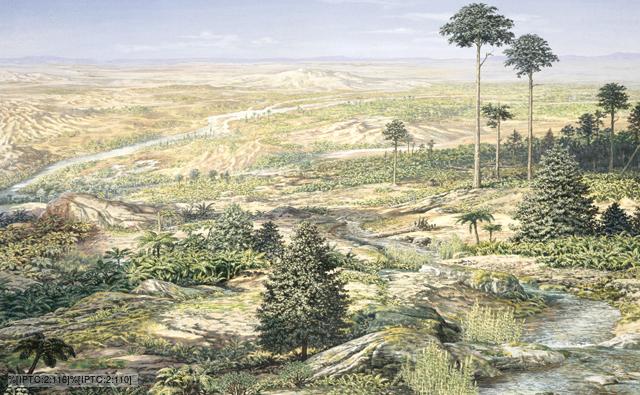 |
Time-Span:
6,000-4,350 years ago
Description:
The
Triassic is the name given to a geological layer in the earth and the
unique pre-Flood habitat(s) this layer represented. It overlies the
Permian habitat and is underlies the Jurassic habitat.
Paleogeography:
Around
6,000-4,350 years ago, the world was one continent called Rodinia.
Fauna:
 |
| Various Triassic species from (left to right): Placerias, Postosuchus, Desmatosuchus. |
A
myriad of different creatures roamed the Triassic
habitats/landscapes. On land, reptiles thrived; one of the most
common forms was called Lystrosaurus,
a relatively small herbivore with a pair of tusks and a beak for
chomping away at plant life. It was a member of the dicynodont
family. Of course, the most famous Triassic animals are the dinosaurs
(even though Triassic dinosaurs themselves don't have the fame of
their Jurassic and Cretaceous counterparts). Some examples of
Triassic herbivorous dinosaurs include: Eoraptor,
Herrerasaurus and
Coelophysis. One of
the largest Triassic herbivores was the mighty Plateosaurus,
a bipedal prosauropod. But dinosaurs are rather uncommon in Triassic
sediments and weren't the top predators of this habitat! Instead,
they were hunted by larger archosaurs such as Postosuchus
and its relative Saurosuchus.
 |
| Pterosaurs like Eudimorphodon flew through Triassic skies. |
In
the air too, reptiles are common in the Triassic. Until recently,
insects and pterosaurs were the only known creatures to fly through
Triassic skies, but birds too lived in the Triassic habitat.
Protoavis is one such
bird and its existence casts serious doubt on the faulty belief that
dinosaurs evolved into birds, as birds appear before
many of the bird-like dinosaurs in the evolutionary fairytale. This
instead is consistent with the Bible's account of creation: Genesis
1:20-23 tells us that flying and sea creatures were made on Day 5 of the
Creation Week, before
dinosaurs and other land animals. Other Triassic fliers include
pterosaurs such as Peteinosaurus and Eudimorphodon
which fed mainly on insects.
 |
| Cymbospondylus was a ferocious predator of the Triassic. |
The
oceans of the Triassic were roamed by strange and wonderful reptiles.
Ichthyosaurs are the most common and largest of the Triassic
reptiles, some such as Shonisaurus
reaching whale-like proportions of around 70 feet in length!
Nothosaurs – fish-eating crocodile or lizard-like reptiles – also
hunted the Triassic seas for food.
Flora:
 |
| The flora of the Triassic was lush and plentiful. |
Plants
of all shapes and sizes could be found in the Triassic habitat
including lycophytes, a type
of cycad, and ginkgophyta. Conifers and seed plants were also very
numerous.
All
of these plants provided food for many of the large herbivores that
lived in the Triassic such as Plateosaurus,
Massospondylus and
Placerias.
Habitat's
Destruction:
The
Triassic habitat met its end with all the other pre-Flood habitats
during Noah's Flood. All that remains of this once thriving habitat
is fossilized in rocks of the Triassic layer throughout the world.

No comments:
Post a Comment